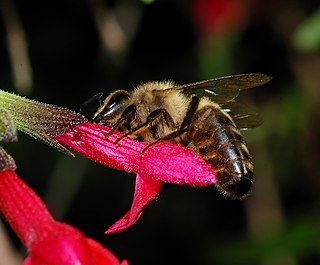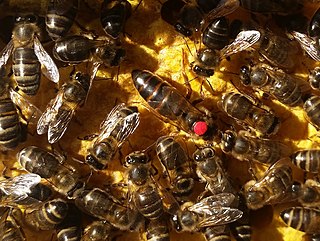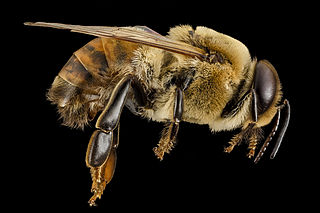Within biological taxonomy, a honey bee race would be an informal rank in the taxonomic hierarchy, below the level of subspecies. It has been used as a higher rank than strain, with several strains making up one race. Therefore, a strain is a lower-level taxonomic rank used at the intraspecific level within a race of a subspecies. Strains are often seen as inherently artificial concepts, more usually within biology as characterized by a specific intent for genetic isolation, however, within beekeeping circles, strain is more likely to be used to describe very minor differences throughout the same subspecies, such as the color ranges of A. m. carnica from brown to grey. Within A. m. ligustica there are two races, the darker leather brown northern Italian bee from the Ligurian Alps region which was discovered to be resistant to acarine in the 1900s, while the other Italian bee race, from regions near Bologna and further south, was highly susceptible to acarine and within this race there are two color strains, the traditional Italian yellow and a rarer all-golden color.

The Apis mellifera mellifera is a subspecies of the western honey bee, evolving in central Asia, with a proposed origin of the Tien Shan Mountains and later migrating into eastern and then northern Europe after the last ice age from 9,000BC onwards. Its original range included the southern Urals in Russia and stretched through northern Europe and down to the Pyrenees. They are one of the two members of the 'M' lineage of Apis mellifera, the other being in western China. Traditionally they were called the Black German Bee, although they are now considered endangered in Germany. However today they are more likely to be called after the geographic / political region in which they live such as the British Black Bee, the Native Irish Honey Bee, the Cornish Black Bee and the Nordic Brown Bee, even though they are all the same subspecies, with the word "native" often inserted by local beekeepers, even in places where the bee is an introduced foreign species. It was domesticated in Europe and hives were brought to North America in the colonial era in 1622 where they were referred to as the English Fly by the Native Americans.

Varroa jacobsoni is a species of mite that parasitises Apis cerana. The more damaging Varroa destructor was previously included under the name V. jacobsoni, but the two species can be separated on the basis of the DNA sequence of the cytochrome oxidase I gene in the mitochondrial DNA.

The Cape honey bee or Cape bee is a southern South African subspecies of the western honey bee. They play a major role in South African agriculture and the economy of the Western Cape by pollinating crops and producing honey in the Western Cape region of South Africa. The species is endemic to the Western Cape region of South Africa on the coastal side of the Cape Fold mountain range.

Apis laboriosa or Himalayan giant honey bee, is the world's largest honey bee; single adults can measure up to 3.0 cm (1.2 in) in length. Before 1980, Apis laboriosa was considered to be a subspecies of the widespread Apis dorsata, the giant honey bee, but in 1980 and for almost 20 years thereafter it was elevated to the rank of a separate species. It was classified once again as a subspecies of Apis dorsata by Michael S. Engel in 1999, but was confirmed as a full species in 2020 on the basis of co-occurrence with Apis dorsata at many sites with no sign of interbreeding. It is highly adapted to its highland habitat in behavior.

Apis koschevnikovi, Koschevnikov's honey bee, is a species of honey bee which inhabits Malaysian and Indonesian Borneo, where it lives sympatrically with other honey bee species such as Apis cerana.
The Maltese honey bee, Apis mellifera ruttneri, is a subspecies of the western honey bee, endemic to the Maltese islands which are situated in the Mediterranean Sea.

The East African lowland honey bee is a subspecies of the western honey bee. It is native to central, southern and eastern Africa, though at the southern extreme it is replaced by the Cape honey bee. This subspecies has been determined to constitute one part of the ancestry of the Africanized bees spreading through North and South America.
Apis mellifera iberiensis, or the Spanish bee, is a western honey bee subspecies native to the Iberian Peninsula. It is also found on the Balearic Islands.

Apis mellifera cecropia, the Greek bee, is a subspecies of honey bee that is native to southern Greece and southern Albania. It is very similar to Apis mellifera ligustica, or the Italian bee. It is favored for its extreme gentleness and lack of tendency to swarm. This species prefers warm temperatures, owing to its Mediterranean origin, and cannot survive in northern Europe's cooler climate. Due to that, they are seldom kept outside of southern Greece.

Apis mellifera intermissa is an African subspecies of the western honey bee.
Apis mellifera cypria(Cyprus honey bee) is a subspecies of the Western honey bee. Its habitat is the Mediterranean island of Cyprus.

Apis mellifera sahariensis is a North African bee subspecies of the species Apis mellifera. It is closely related to Apis mellifera intermissa in the region.
Apis mellifera adami is a western honey bee subspecies, endemic to the island of Crete in the eastern Mediterranean.
Friedrich Ruttner was an Austrian SA-member, NSDAP member, SS-physician, neurologist, zoologist and bee expert. He became internationally known for his advances in honey bee breeding, instrumental insemination, classification of various subspecies and as a co-founder of Apidologie.
Apis mellifera adansonii(Western African bee) is a subspecies of the Western honey bee with probably the largest range of Apis mellifera in Africa, belonging to the A (Africa) Lineage of honey bees. Originally identified by Michael Adansonin in his Histoire naturelle du Seneegal in 1757. Initially the name adsansonii was misapplied to A. m. scutelleta and in particular to the Africanised bees of South America.
Apis mellifera unicolor is known by the common name of the Madagascar honey bee, sometimes also called the Malagasy honey bee. It is endemic to the island of Madagascar.
Apis mellifera meda is known by the common names of the Median honey bee or the Iranian honey bee. Its range covers the non desert areas of most of Iran and Iraq, but also into southeastern Turkey, across northern Syria as far as the coast of the Mediterranean. Colonies have been observed in the Azarbaijan Iranian highlands at elevations up to 3,000 m (9,800 ft). Initially based on morphometric evaluation, but then later confirmed with DNA analysis, they belong to the O Lineage of Apis mellifera.

A drone congregation area is an aerial region where honeybee drones and virgin queens gather to mate.










